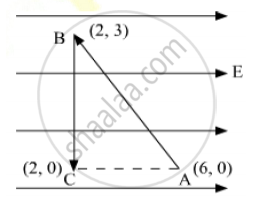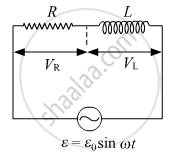Advertisements
Advertisements
Question
Find the potential difference between the points A and B and between the points B and C of the figure in steady state.

Solution
Equivalent capacitance of the circuit can be calculatesd as,
Ceq:-
\[1 \mu F\text{ is in parallel with, }C = \frac{1}{\frac{1}{(3 + 3)} + \frac{1}{(1 + 1)}} = \frac{3}{2}\mu F\]
So, \[C_{eq} = \frac{3}{2} + 1 = \frac{5}{2} \mu F\]
V = 100 V
Total charge in the circuits is,
\[Q = C_{eq} V = \frac{5}{2} \times 100 = 250 \mu c\]
As the volatge across 1μf is 100 V, therfore charge stored on 1 μf capacitors = 100 μC
Charge flowing from A to B = (250 - 100) = 150 μC
Ceq between A and B is 6 μf.
Potential drop across AB,
\[V = \frac{Q}{C}\]
\[ \Rightarrow V_{AB} = \frac{150}{6} = 25 V\]
Potential drop across BC = (100 - 25) = 75 V
APPEARS IN
RELATED QUESTIONS
A metal rod of square cross-sectional area A having length l has current I flowing through it when a potential difference of V volt is applied across its ends (figure I). Now the rod is cut parallel to its length into two identical pieces and joined as shown in figure II. What potential difference must be maintained across the length of 2l. so that the current in the rod is still I?

Explain the principle of a device that can build up high voltages of the order of a few million volts.
Draw a schematic diagram and explain the working of Van de Graff generator device.
Is there any restriction on the upper limit of the high voltage set up in Van de Graff generator machine? Explain.
A test charge ‘q’ is moved without acceleration from A to C along the path from A to B and then from B to C in electric field E as shown in the figure. (i) Calculate the potential difference between A and C. (ii) At which point (of the two) is the electric potential more and why?

A charge of 20 µC is placed on the positive plate of an isolated parallel-plate capacitor of capacitance 10 µF. Calculate the potential difference developed between the plates.
Answer the following question:
Find the expression for the resistivity of a material.
What will be the potential difference in the circuit when direct current is passed through the circuit?

If a positive charge moves in the direction of the electric field ______.
The unit of potential difference as used in electrical circuits is ________.
Two metal pieces having a potential difference of 800 V are 0.02 m apart horizontally. A particle of mass 1.96 × 10–15 kg is suspended in equilibrium between the plates. If e is the elementary charge, then charge on the particle is ______.
On moving a charge of Q coulomb by X cm, W J of work is done, then the potential difference between the points is ______.
- It depends only on the initial and final position.
- It is the work done per unit positive charge in moving from one point to other.
- It is more for a positive charge of two units as compared to a positive charge of one unit.
An α-particle and a proton are accelerate at same potential difference from rest. What will be the ratio of their final velocity?
Work done in moving a unit positive charge through a distance of x meter on an equipotential surface is:-
